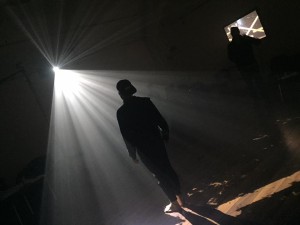The law of conservation of energy states that the total energy of an isolated system is constant; energy can be transformed from one form to another, but cannot be created or destroyed.
Francesca Pickard
Little did I know, when I joined Angharad Lee on this second phase of R & D for Chris Chibnall’s Kiss Me Like You Mean It, that within days I would be quoting the first law of thermodynamics. My dad, a scientist, has tried to teach this important rule to all of his grandchildren as soon as they were able to talk, while I sat back and scoffed, but never have I been more aware of the true simplicity and unexpected comfort of this edict.
Kiss Me Like You Mean It is a moving story about where relationships begin and where they end. Not an original concept for a play but nonetheless a pretty fundamental aspect of the human condition. In a block of flats where a house party rages on the ground floor, spilling out into the garden, lovable lad Tony attempts to woo the reticent Ruth, while above in their first floor flat, ageing romantics, Don and Edie, celebrate their life-long connection. And it is connections that this production really seeks to explore. What is the transfer of energy between two individuals when they meet and how might this be communicated to an audience? How might the characters’ pathways and destinies be realised for an audience and what does this representation say about us all?
Angharad’s concept for the piece is to represent the characters’ lives as a blueprint, like architectural drawings or a series of maps layered upon one another. As the characters move through this night’s journey, they create, re-tread and erase paths like a child with an Etch-a-sketch, drafting, shaking and redrafting pixelated lines on the screen. These paths, however, are not sculpted and structural, their texture has more in common with a virus or fungus spreading under a microscope or dandelion seed heads transported on the breeze. They are a fluid and intangible energy, like smoke or dust particles dancing in the light but they are most definitely present.
The paths, created through projection mapping, give the performance a distinct style and with the removal of extraneous props and set dressing, this once ‘straight play’ becomes a visceral being that cuts straight through the external actions of the characters to the internal core of what it is to be connected to another person.
Much of the rehearsal this week has been about discovering movement sequences that might serve as motifs within the physical life of the play. These can act as anchors for the actors but also as the primary stimulus for the projection mapping, which involves very precise use of projection onto gauzes, the floor and even bodies. Ensuring these sequences are actor-led and rooted in their physical response to the text gives them an authenticity but also means that each character’s individual physicality is represented within the mapping.
Our days have also been occupied with exploring the inner life of the characters, their tempo rhythms, ‘wills and wants’, and of course discovering the humour within the piece which serves as a crutch, enabling the characters to mask their darkest fears and function in the face of crippling uncertainty. There have been a fair few tears this week but an awful lot of laughter.
Crucially though, what does applying this approach do for the text in performance?
For our more experienced actors, physical theatre and projection mapping has been a venture into the unknown. Their natural instincts regarding how to communicate with the audience and one another have been challenged and stripping back their performances has not come easily but the result is staggeringly pure and deeply moving.
There has only been time to create a couple of sequences over the two days spent with Zakk Hein and his array of technical equipment but the texture of the piece has emerged and there is something new to see in each projection every time it is repeated. The aesthetic is beautiful in its own right but from a theatrical perspective it is what it adds to the storytelling and how it supports the action of the piece that makes it so effective. The opening sequence, where Tony moves along ever changing pathways, looking for his own route, has a childlike playfulness to it but also an urgency and a precarious fragility as though, at any moment, a missed pathway might mean he fails to make his appointment with destiny. It is a powerful metaphor for the way we all grasp at finding direction in life.
This production seeks to combine primal forces and scientific truths with new technology. There is a melancholic climax to the piece but there is also a swell of optimism that perfectly encapsulates that reassuring law of thermodynamics, nothing really ends, energy is neither created nor destroyed, just passed between us all.

